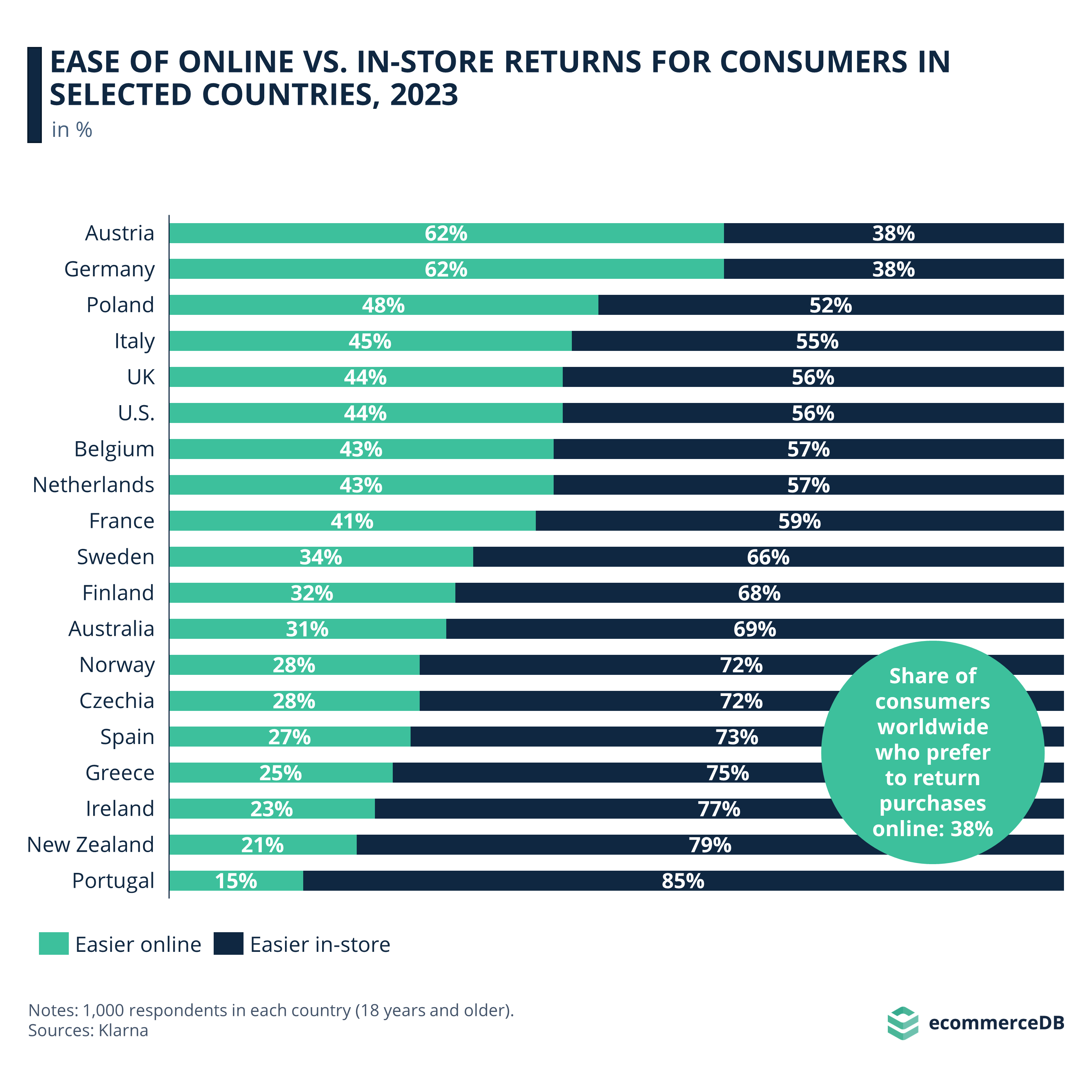eCommerce: Online vs. In-Store Returns Analysis
Online vs. Offline Returns: Global Customer Preferences
The U.S. and Germany are among the world’s most highly developed eCommerce countries. This is reflected in customer preferences: In both countries, the share of shoppers preferring online over in-store returns is above the global average. Where do countries like Italy, France, Australia or New Zealand stand?
Article by Lucia Laurer | October 04, 2023
Customer satisfaction stands as a paramount factor in the success of online businesses. One critical aspect that influences customer satisfaction is a convenient return process for purchased items. Klarna, a leading eCommerce payment solutions provider, recently conducted a global survey to gauge consumer perceptions about product returns – to be more precise: whether they find it easier to return a purchased item online or in-store.
The results, collected from various countries, shed light on the significance of streamlined return processes and the adaptation to customer preferences in the eCommerce landscape. However, it also turns out that there is no universal remedy, no one-size-fits-all approach. eCommerce players need to take into account that customer expectations differ substantially between countries – at least in the context of returns:

eCommerce Returns – The Global Perspective
The survey encompassed a range of countries, each offering unique insights into consumer preferences for returns. Globally, the findings revealed that 62% of consumers find it easier to return items in-store, while 38% favor online returns. This trend underscores the enduring trust and convenience that many people still place in offline channels in retail. It also shows the prevailing challenges that eCommerce platforms face in ensuring seamless return experiences and increasing customer satisfaction.
Regional Nuances in Consumer Choices
While the global average suggests a preference for in-store returns, examining individual countries reveals intriguing variations in consumer behavior. Countries like Austria and Germany lead the list, with 62% of respondents, in fact, preferring online returns. The UK and the U.S., as two more highly developed eCommerce countries, also show an online preference above the global average. Conversely, Southern European nations such as Greece (75%) and Portugal (85%) demonstrate a strong inclination towards in-store returns.
Online vs. Offline Returns – The Bottom Line for eCommerce Players
These regional variations might be attributed to a combination of factors including cultural norms, technological infrastructure, and the maturity of eCommerce markets. In areas where eCommerce has gained a strong foothold, consumers might tend to be more comfortable with in-store returns.
The data underscores that businesses must adapt to evolving customer preferences in eCommerce – and to the specific needs of their relevant target populations. Neglecting to offer user-friendly in-store return options can lead to dissatisfaction and potential loss of customers in certain countries.
Online vs. Offline Returns: Global Customer Preferences – Key Takeaways
Significance of a Streamlined Return Process: The article emphasizes the importance of a convenient return process in influencing customer satisfaction for online businesses. Klarna's global survey results indicate that while 62% of consumers globally find it easier to return items in-store, 38% favor online returns.
Regional Variations in Return Preferences: Consumer behavior differs by country, with nations like Austria and Germany preferring online returns (62%), while Southern European countries like Greece (75%) and Portugal (85%) show a strong inclination towards in-store returns. The UK and the U.S. also show an online return preference above the global average.
Adaptation is Key for eCommerce Success: The variations in regional preferences are influenced by factors such as cultural norms, technological infrastructure, and the maturity of eCommerce markets. For online businesses to succeed, they must be attuned to these preferences, especially concerning returns, to meet the specific needs of their target demographics and prevent potential customer loss.

Click here for
more relevant insights from
our partner Mastercard.
Related insights
Deep Dive
YouTube Partners With Flipkart and Myntra to Launch YouTube Shopping in India
YouTube Partners With Flipkart and Myntra to Launch YouTube Shopping in India
Deep Dive
Kaspi to Acquire Stake in Hepsiburada, Expanding Presence in Turkey
Kaspi to Acquire Stake in Hepsiburada, Expanding Presence in Turkey
Deep Dive
Jumia Business Analysis: Top Markets, Revenue, GMV & eCommerce in Africa
Jumia Business Analysis: Top Markets, Revenue, GMV & eCommerce in Africa
Deep Dive
Temu Is the Second Most Visited eCommerce Website in the World
Temu Is the Second Most Visited eCommerce Website in the World
Deep Dive
Indonesia Urges Apple and Google To Restrict Temu
Indonesia Urges Apple and Google To Restrict Temu
Back to main topics